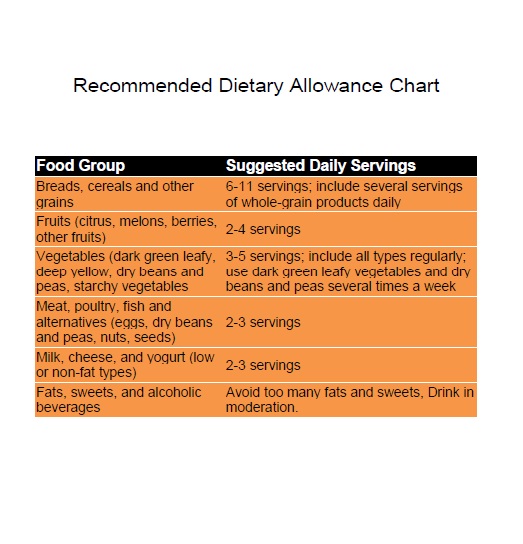If you want to discover the recommended dietary servings... This article will give you a brief explanation... and...A printable chart that you can download and print.
The USDA Food Guide prioritizes food groups to help individuals obtain their Recommended Dietary Allowance. Although your calorie needs depends on your age, gender, size, and activity level, you should try to eat the right amount of servings for each group.
Click Here To Download Recommended Dietary Allowance Chart Pdf
Recommended Dietary Allowances (RDA’s) are standards to serve as a guide or goal for good nutrition. According to the Food and Nutrition Board of the National Research Council the RDA’s are the amounts of specific essential nutrients necessary to meet the known nutritional needs of most normal healthy persons in the United States.
They are indicated as average amounts over a period of time. The RDA’s are to be used for groups or populations rather than for analysis of daily diets of individuals. The recommended amounts are set high enough to meet the needs of 98% of all normal healthy persons. Therefore, dietary intakes below the RDA’s do not necessary indicate a deficient intake.
American Heart Association (AHA) Dietary Guidelines
The major AHA dietary guidelines for individuals involve eating and exercise behaviors and are summarized below:
1. Consume a variety of fruits, vegetables, and whole grain products.
2. Consume low-fat and fat-free dairy products, fish, legumes, poultry, and lean meats.
3. Match intake of energy (calories) to overall energy needs.
4. Limit consumption of foods with high caloric density and/or low nutritional quality.
5. Maintain a level of physical activity that achieves fitness and balances energy expenditures with energy intake; for weight reduction, expenditure should exceed intake.
6. Limit the intake of sodium to below 2400 mg per day.
7. Limit alcohol consumption to no more than 1 drink/day for women and 2 drinks /day for men.
8. Achieve and maintain a desirable blood lipid profile including total blood cholesterol, LDL cholesterol HDL cholesterol, and triglycerides.
9. Limit consumption of saturated fat, trans fatty acids, and cholesterol.
10. Increase consumption of foods rich in omega 3 fatty acids and some monounsaturated fats, if substituted for saturated fats.


